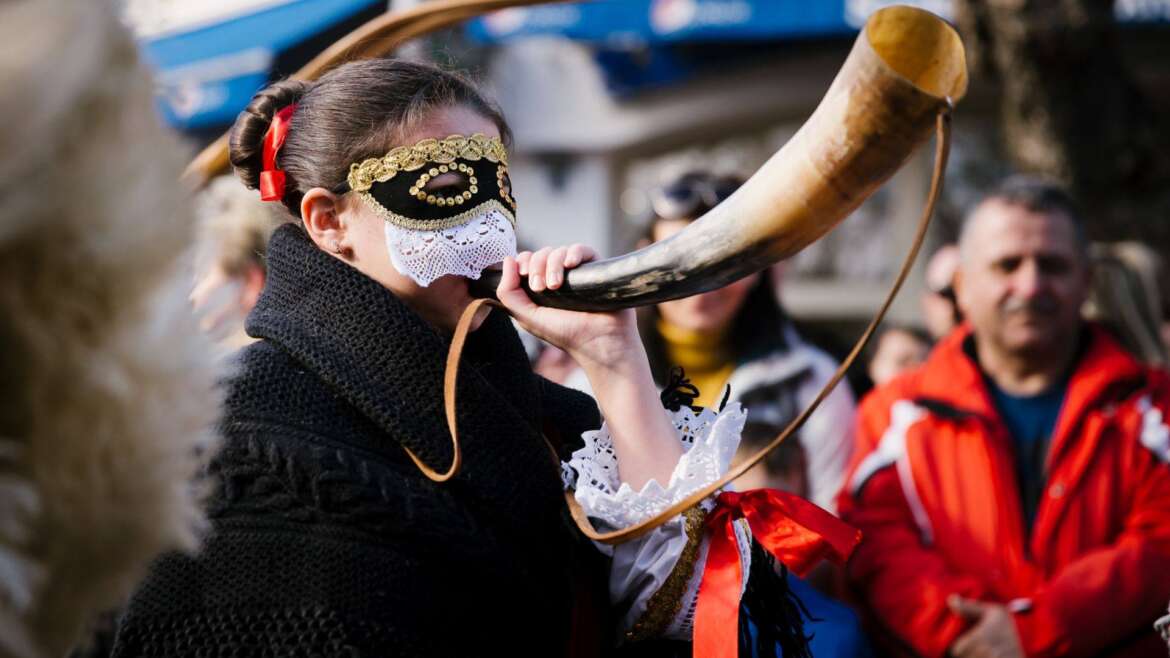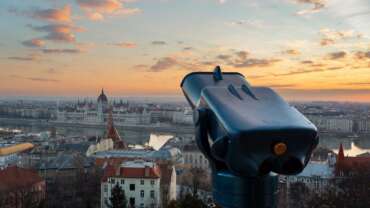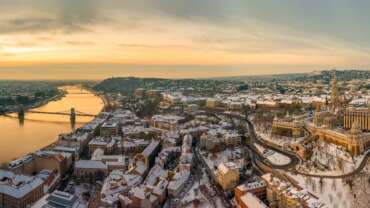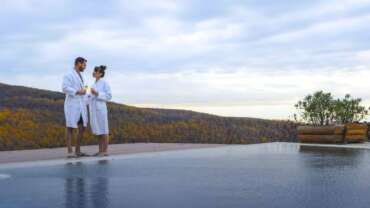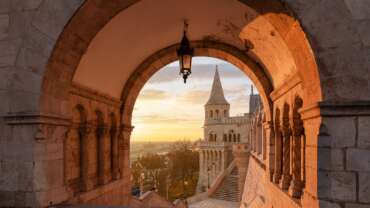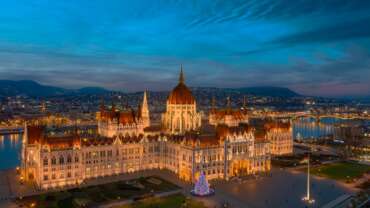Experiences in Hungary
Hungary for Explorers
Adventures in the Zemplén Mountains
The tourist trails located in the central section of the Zemplén Mountains – rich in fortresses and castles – occasionally traverse forests that appear untouched by man.
Of these, the most important one is the National Blue Trail, which stretches from the highest point of the Transdanubian region, Írott-kő, to Hollóháza, with a length of no less than 1100 km. It passes several lookout points, from which you should not miss the Nagy-Péter-mennykő and the Kis-Milic. If you get thirsty, you can quench your thirst from the numerous springs in the area.
The Sólyom Crag is a preferred location for rock climbers. From the peak, you might even spot the distant ruins of the Castle of Regéc. If you fancy mountain biking, you are once again on the right track: the Hungarian section of the Eurovelo 11 international cycle route runs through the area. Would you rather sit back comfortably to enjoy the receding countryside? The Pálháza Forest Railway runs along the valley of the Kemence Stream, traversing the most beautiful parts of the nature reserve.
Hungarian Gastro Glossary
Egészségedre! When the Hungarians raise a glass in a toast, they say “to your health”, i.e. may the content of the glass turn into good health for you. Non-Hungarian speakers may not find it easy to pronounce, but Hungarians are always touched by any attempt they make to do so.
NOKEDLI (DUMPLINGS)
This is a distinctive Hungarian pasta made from just flour, eggs and salt and cooked in sparing amounts of water. This is the most popular side dish for that iconic Hungarian culinary delight, paprika chicken, a type of chicken stew.
PÁLINKA
This is a strong alcoholic drink, which is made only in Hungary and only from fruit grown or grape marc produced in Hungary; it has to be fermented and distilled using traditional methods. Every Hungarian will announce with conviction that the best ever pálinka is distilled by one of their relatives. The clearer and fruitier it is, the better the quality of the pálinka.
KÖRÖZÖTT
Curd cheese made from cow’s or even sheep’s milk and mixed with typical Hungarian paprika and ground caraway seeds: this is a favourite at the Hungarian breakfast table or at teatime.
SZALONCUKOR (CHRISTMAS FONDANT)
This is a Hungarian creation: a characteristic sweet, dipped in chocolate and wrapped in tissue paper or colourful foil to hang on the Christmas tree. Nowadays, they are made with all kinds of fillings, but the more traditional ones are filled with marzipan or jelly.
RÉTES (STRUDEL)
Served for dessert, this is a stuffed flaky pastry, which is actually not an original Hungarian recipe, but the Hungarians have commandeered it as their own. Most commonly, the pastry is filled with poppy seeds, sweetened curd cheese, apple or sour cherries, but potentially with any combination of these.
TÚRÓ (CURD CHEESE)
Curd cheese is made from milk and is basically a freshly made cheese, white in colour, with a lumpy, crumbly texture and a sour flavour. Hungarians are enthusiastic consumers of “túró”, be it made from cow’s or sheep’s milk. It finds its way into sweet as well as savoury dishes, onto pasta as a main course with chopped, fried bacon and as an ingredient for desserts.
POGÁCSA
Generally speaking, this is a kind of savoury scone and characteristically served in Hungary as a starter when welcoming guests. It can be made with different additional ingredients such as potato, cheese, butter, curd cheese, cabbage or crackling.
Fisherman’s Bastion
The 140 m facade of the Fisherman’s Bastion in the Buda Castle District offers splendid views of the city and is a great spot for photos of another key attraction, the Parliament.
One of the most outstanding examples of Hungarian eclecticism, the Fisherman’s Bastion is located in District I of Budapest, in the Buda Castle District. The edifice is an important part of the cityscape and has been a UNESCO WORLD HERITAGE SITE since 1987. It’s worth taking a walk along its 140 metre long facade to enjoy the stunning view and the chance to take fabulous photos of another important attraction, namely the Parliament.
Hidden archaeological treasures
The original purpose of the Fisherman’s Bastion was defence, as part of THE BUDA CASTLE wall. The bastion was named after the Fishermen’s Town lying beneath and when necessary, the fishermen living here defended the tower. Renovation works started in 1899, based on plans by the architect Frigyes Schulek. The bastion was opened to the public on 9 October 1905. One reason the works took so long was the many major archaeological finds at the site, including Gothic and Renaissance tombstones, as well as the sanctuary of a one-time Dominican church. Frigyes Schulek’s idea was for the three-stage staircase, the northern and southern bastions, the corridors and the southern bastion yard to form the whole of the structure. He designated the former Telegraph Bastion as the northern tower, while he built the southern one himself. The equestrian statue of the first Hungarian King, Saint Stephen, is located in the courtyard. The statue is the work of Alajos Strobl and the foundation is decorated with reliefs that pay homage to outstanding moments of King Stephen’s reign, such as his coronation. The stone towers represent the seven tribe leaders who led the Magyars when they settled in what is now Hungary. The Fisherman’s Bastion was in need of renovation once again after World War II. This time, the works were led by Frigyes Schulek’s son, János Schulek, but it was only delivered many years later, in 2003.
The world-famous panorama
Besides becoming one of Budapest’s most visited tourist attractions over time, the edifice is also a popular filming location: it features, for example, in music videos by two world-famous singers, Ellie Goulding and Selena Gomez. Just a few steps from the Fisherman’s Bastion is MATTHIAS CHURCH, which also functioned as a coronation site. You just have to climb 197 stairs to get to the wreath-shaped balcony of the church tower.
Megyer-hegy Tarn
Among the hiking spots in the Zemplén Mountains, the lake on the 324 metre high, volcanic Megyer‑hegy is one of the most popular. The tarn was previously a millstone mine; its remains are visible to this day. Let’s head for the northeastern corner of Hungary.
As long as you’re in the Tokaj‑Hegyalja region, visit the Megyer-hegy Tarn, near the town of Sárospatak, also known as ‘Athens on the shores of the Bodrog’. Shaped by natural forces and human hands alike over the years, it became a nature reserve in 1997. A millstone mine operated on the volcanic hill from the 15th century until 1907. As rainwater collected in a pit carved into the tuff, it formed a pond, with massive rock walls towering from the waters. Signs of the hard-working miners who lived here for many years are everywhere: their small ‘stone flats’ are still evident today, as are some half-finished millstones. Put on some comfortable hiking boots and make your way up the 324 metre high hill. You will be well rewarded: the rock cauldron rising from the middle of the forest is truly an imposing sight. In 2011, the tarn was chosen as the most beautiful natural wonder in Hungary. Currently, rope bridges and the longest via ferrata in Hungary are also under construction.
As long as you’re visiting the World Heritage sites of Tokaj‑Hegyalja, it would be worth taking a little detour to the tarn on Megyer-hegy, the hill rising above the ancient town of Sárospatak, affectionately known as ‘Athens on the shores of the Bodrog’. The long, uphill hike is well worth the effort: the mere sight of the rock cauldron bursting forth from the forest is enough to give one chills. The sight is both beautiful and terrifying, a testament to the shared power of natural forces and human hands.
A tarn carved in tuff
Filled with rainwater, the lake presents a gorgeous sight in all seasons. It is surrounded by vertical rocks, 70 metres tall in some places. Its maximum depth is 6.5 metres. The tarn is a true testament to the shared power of natural forces and human hands, and in 1997, it became an official nature reserve. It operated as a millstone mine from the 15th century to 1907, as the Megyer-hegy is made of rhyolitic tuff, which was permeated by silicic acid solutions during the hill’s post-volcanic activity. As a result, the tuff hardened, the quartz particles inside giving it excellent characteristics for polishing and milling. The miners carved small dwellings in the rock for themselves, which are still there today, along with a few half-finished millstones.
The tarn is accessible via several different hiking trails. Whether you’re arriving from the vineyards of Tokaj‑Hegyalja or the village of Botkő, you would do well to put on a pair of comfortable hiking boots.In addition to the longest via ferrata in the country, rope bridges and a bicycle path, a lookout tower is also under construction at the tarn’s highest point. A showroom is also planned, displaying the history of millstone manufacturing in the 15th-17th century to visitors. Currently, the water-filled rock cauldron is visible from the edge of the mine and can be viewed from behind safety railings. Visitors can also walk all the way to the edge of the lake – that is, inside the old mine – through a narrow passage that was originally used to transport rocks from the mine.
A tarn near the romantic wine region
If you’re up for an all-day hike, you should definitely try the Malomkő (Millstone) tourist path. This is a 4-5 hour hike from Sárospatak, starting off from the school garden of the Reformed College. Its total length is approximately 12 kilometres. The environmental educational trail includes 17 stations. Among others, it passes by the lovely little Swabian village of Hercegkút, the Megyer-hegy Tarn, Király-hegy, the geyser cone at Nagy-Bot rock, the historical wine cellar systems of Gomboshegy and Kőporos, and also presents the natural and artificial flora present in the region. The tour concludes at the castle garden of Rákóczi Castle in Sárospatak, where you can admire an ancient Japanese pagoda tree, the trademark species of the region.
Tokaj Wine Region
The major wine region is comprised of Tokaj and the surrounding 26 settlements. Its natural boundaries are Sátor Mountain, Kopasz Mountain, and the Tisza and Bodrog rivers. This area is considered a separate wine region of its own, due to a number of unique features: one being the local climate, which is very conducive to noble rot, and the other being the wet marshlands near the rivers. The vineyards are located on exceptionally colourful volcanic rock formations, at a height of approximately 100-300 metres above sea level.
It is said that Louis XV called the Aszú wine from Tokaj-Hegyalja the king of wines and the wine of kings, but Mozart and Goethe were also supposed to have been extremely partial to it.
In other words, you should certainly not consider your trip complete until you have tasted a glass of Furmint or Aszú immersed in the unique atmosphere of the centuries-old cellars, perhaps while listening to the stories of a winemaker hailing from TOKAJ, MÁD or Erdőbénye.
TOKAJI ASZÚ is one of the most unique sweet wines in the world, a true miracle of nature. Its production requires the proliferation of noble rot, which in turn is made possible by the formation of water vapour in the autumn. Another important factor is the autumn sunshine, which allows for the concentration of sugar and other important elements within the grapes, giving the wine its unique character. During the harvest, the individual valuable Aszú grapes are collected separately, then soaked in a suitable proportion of stum or base wine of the same vintage. After the fermentation and pressing, several years of aging gives birth to the incomparable taste of Aszú wine.
The region has remained unique in this regard for centuries, due to its rich geological history, the many types of rock and soil present in the area, its precise geographical location, the vicinity of several hundred formerly active volcanos and the beneficial microclimate in the area, as well as the varied cellar systems in the nearby vineyards and settlements. It is the interplay of all of these factors that made the wine of Tokaj – especially Tokaji Aszú – world-renowned, and helped these extremely rich, dry wines grow in popularity. The two main varieties of wine in Tokaj are Furmint and Hárslevelű, but Muscat Blanc à Petits Grains (Sárgamuskotály), Kabar, Zéta and Kövérszőlő are some other varieties of grapes that are also used in wine production. In addition to wine production, Tokaj also has rich traditions relating to the cooper’s profession.
The sessile oak in the ZEMPLÉN MOUNTAINS is excellent raw material for barrels, making ‘Zemplén oak’ a mainstay of the international wine world. Erdőbénye, also known as the ‘Valley of the Coopers’ is well known for nurturing and keeping alive the traditions of the craft. In 2002, UNESCO added the region to its list of WORLD HERITAGE SITES, as the Tokaj Wine Region Historic Cultural Landscape.
Take a dip in Lake Hévíz, the world’s largest thermal lake.
Do you crave some refreshing, revitalising or relaxing bathing? Do you feel your joints would benefit from some natural medicinal therapy? Do you also want to throw in a beautiful environment, a magical turquoise lake, with multi-coloured water-lilies and green trees? Then go to Hévíz!
Lake Hévíz is located alongside the Northern slope of Mount Keszthely, in the centre of the town of Hévíz. Did you know that it is the largest biologically active natural thermal lake in the world? If this does not make Lake Hévíz special enough in your eyes, here are a few more facts. Thanks to constant movement, the temperature of the water is pleasant throughout the year, allowing you to bathe in any season. The water temperature is 23-25°C in the winter, and can climb as high as 36-38°C in the summer. The way the water flows from left to right as well as from the bottom upwards provides a massage of sorts for those sitting in it. In winter, the condensed steam forms a cap over the lake surface, creating a natural inhalatorium. This ‘cap’ prevents water from cooling down, rejuvenating exhausted vocal cords when inhaled. The lake developed in the same period as Lake Balaton, with its current source welling up 20-22,000 years ago. (In the geological past, Ancient Hévíz welled higher than its current location.) The lake was already used by the Ancient Romans. Several water-lily types inhabit the lake: the European white water lily is indigenous to the area, while the purple lily was brought from India 100 years ago. Thanks to an abundant water supply, the water of the 4.4 ha lake – with a depth of 38 m – is fully replaced every three days. Water quality is continuously controlled through measurements and specially trained divers.
The healing effects of Lake Hévíz
The water of the lake has a very special composition, containing sulphur, calcium, magnesium and hydrogen carbonate. It is extremely rich in minerals and, as such, is very effective in treating numerous illnesses – to truly combine treatment and relaxation. It is mainly used for the following health problems: rheumatic musculoskeletal disorders, degenerative and chronic joint diseases, osteoporosis, post-op treatment for musculoskeletal surgeries, post-op treatment for slipped disc, nervous system-related complaints arising for mechanical reasons, chronic gynaecological illnesses, chronic back pain, various skin disorders (such as psoriasis).
It is important, however, to remember that you shouldn’t spend more than 30 minutes at a time in the water.
If healing is not your primary objective, Lake Hévíz is still an ideal choice as in addition to refreshing or relaxing bathing options, it also provides various wellness services of Western European standards. Indulge yourself with (among other things) an underwater jet massage, the medicinal mud pool, the salt cave or a steam bath – essentially whatever you desire. In addition to relaxing, the area has countless active programmes on offer: exquisite hiking trails, Segway opportunities, horse-riding and unforgettable gastro experiences.
An unparalleled aquatic experience
It’s only fair that we tell you in advance: if you crave the ‘traditional’ beach experience, Lake Hévíz is not what you’re looking for, as the atmosphere here is special and very unique with unparalleled natural properties. If you are more the type for traditional beaches, Lake Balaton is only 6 km from Hévíz. If you’re already in the region, make sure you visit the wonderful BAROQUE-STYLE FESTETICS PALACE, the third-largest in the country, to get a taste of the opulent lifestyle of noblemen, or visit THE BENEDICTINE ABBEY OF TIHANY and immerse yourself in living history.



